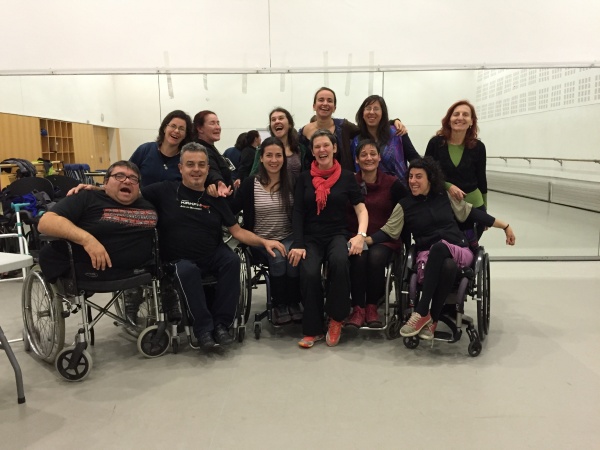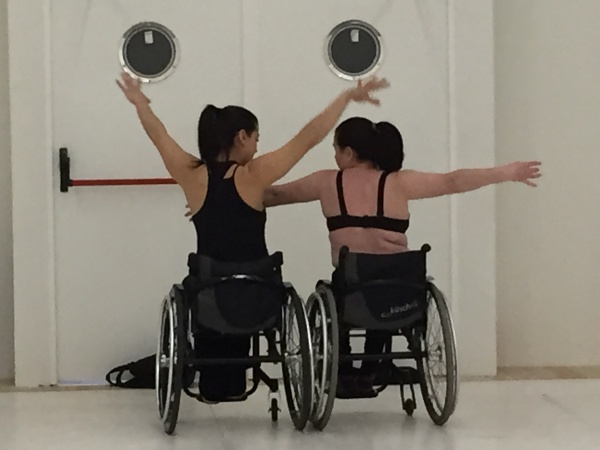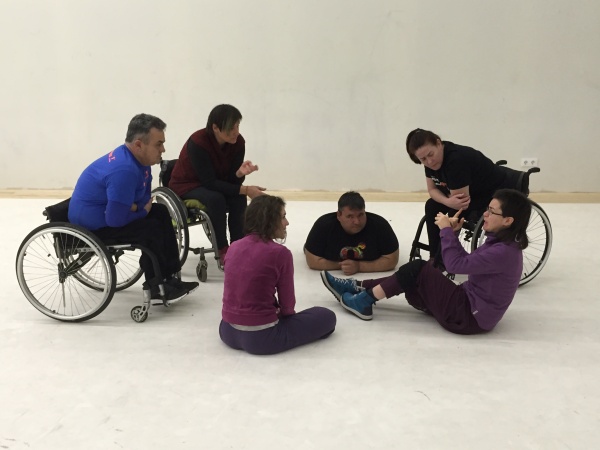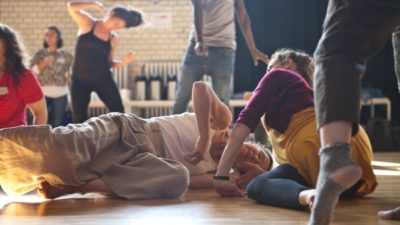Reflecting on her time in Barcelona working on a mentoring project led by British Council Spain, Janice Parker writes with passion and aplomb about the innovation in dance made possible by the potential for disabled choreographers to break convention and invent new modes of expression.
I have a deep love of training and mentoring, passing on skills and knowledge, tapping into possibility and potential and witnessing people and art, flourish. It is part of my politics. The politics of my practice lies in the area of ‘who and what is not yet valued, why is it not and what are we missing because of this?’

It resonates with another mantra of mine, stolen (with permission!) from disabled choreographer, activist and dance-maker Caroline Bowditch. She asks “who has the right to dance and what can dance be?” What a great provocation.
I was recently invited by the British Council to lead on a nine-day choreographic development workshop – a first time opportunity for experienced disabled dancers from Barcelona to develop their choreographic skills.
Right up my street… the start of a new revolution, professional development, investment in people as art makers, new voices and visions, valuing the aesthetic of disabled dance-makers, ownership and authorship, valuing difference, investment in the next generation of innovative, provocative dance-makers, aiming for excellence… I could go on.
Ten dancers signed up. I started by saying: “you will not become a choreographer in nine days nor should you be aiming to be! But you will have the chance to discover and ignite your artistic flame, on your own terms and in your own way.” I wanted to set them on fire politically, personally and artistically, for them to have a sense of their own possibility and potential, and to gain enough skills and knowledge to feel equipped to ask the right questions in the future.
We began with questions: what is choreography? Why? Who and what inspires you? Why? What is ‘not good’ choreography? Why? We talked about the politics of disability-led dance and where it sits in the world currently and historically. And we looked at each person’s kernel of an idea as the start of an enquiry, as an investigation and as a deep desire to make and create dance.
This is a process, not of training as such, but one of sharing – a sharing of skills, knowledge and experience. It is also an intuitive open response to who is in front of me and what they bring. In that way the process is a dialogue, a reciprocal exchange and collaboration that unfolds, where ‘participants’ are authors from the start. It is based on questions, asking the right questions at the right time and questions as provocations, the aim of which is not necessarily to find an answer.

The art of observation is a requirement: looking, listening, reflecting, responding and working in the moment – but held in a clear frame of where you want to be by the end. There is attention paid to what is missing, what questions are not asked, what is not yet known and there is a responsibility to evoke and provoke these things. In short, I know where I think I’d like to be at the end of the process, but the journey is informed by who people are and what they bring to the table.
In Barcelona we focused on choreographic process, how you start, where you start from, what you start with and how you build on that. For me, choreography comes from the heart and soul. It is a personal vision as well as a set of skills that need studied, crafted, nurtured, refined, exploded and in the end is something that ‘feels right’ to its author and generator.
The hardest thing for these new choreographers was moving from their idea to the embodiment of that idea. Finding vocabulary, trusting that vocabulary, finding meaning within it, knowing why it was there and how to value it were the biggest challenges. All choreographers know that challenge well.
What was not a challenge was the fact that the vocabulary, because of the bodies creating it, was deliciously diverse and innovative. I witnessed people work deeply and thoroughly into their own movement possibility, challenging themselves to go further and find new aspects of their own, or each others, registers and vocabularies, and then make meaning from that. Some of that vocabulary was breathtaking and hugely exciting. Some of it was funny, or politically pointed. Witnessing people work from the agency of their own bodies and selves is an immensely invigorating process.
The emergent choreographers were full of doubt with a dose of excitement. They were at the start of the journey of creating their own work. For any choreographer that is a hugely exposing and daunting place. They doubted their own abilities, the content they were creating, the vocabulary, but not because it was authored by a disabled choreographer working on a disabled body – be that their own body or someone else’s – but because it was personal. It was a personal risk. They were putting themselves on the line.

But, there is a difference for this group of choreographers, a difference precisely because they are disabled, and that is the question of how will their work with its specific and diverse vocabularies and body types be received, valued and supported within the frame of current contemporary dance practice? And why should it?
My belief is that dance needs these new vocabularies. Why are we so stuck on such a hierarchical approach to what dance is and on the body type that dance demands? This normative frame of reference with an elite particular body at the top of a hierarchy signals that anything other than this is of lesser value.
Instead we could be asking what does it mean to work from a different experience of movement and the body? What does that contribute? And how can we support these new vocabularies, dance forms, people and body-types in their making and creating?
We need innovation in form and function. Art is not and never has been in its essence, something that has stood still. Diversity and difference in body types, languages and vocabularies of movement, and in life experience brings with it the potential for deep innovation, radical challenge and a development of current contemporary practice.
And what does it mean to author your own work? Why should you? Authorship and ownership is a big theme in current disability dance politics and an important one. There is an artistic and a political difference between a disabled artist making their own work and them being part of someone else’s artistic vision. We need these voices and bodies to be at full volume and currently work choreographed and authored by disabled people is still a missing link in the chain.
And finally, what was particular about Barcelona? For me it was the sheer number of disabled dancers attending the workshop along with their confidence in and awareness of the landscape of their own bodies. They are hungry and on fire, ready to go further into choreographic practice.
There is also real potential, and interest, within the city and its cultural organizations to further develop the existing infrastructure, resources and opportunities for these emerging choreographers to continue on their journey.
Through sharing practice, politics and experience we can do this on an international level and on a local level at the same time, building partnerships and working collaboratively together.
We need to remember there is no one-way and no right way to do this. The best is to look at providing diverse routes, access points and opportunities in training and mentoring and to create responsive resources and opportunity, different ways in, different ways through.
And we need to ask ourselves what do we mean by disability-led dance and whose voices and bodies are we thinking of? Diversity within the disability-led world is as much of a necessity as it is a diverse form in itself. How diverse are we willing to go?!
The task is to build confidence in the disabled makers and creators as well as confidence within the current dance landscape and to nurture, encourage and support the next generation of innovative, provocative and excellent disabled dance-makers.
I wonder, who will be dancing and what dance will be.



